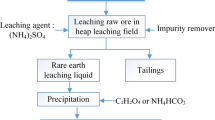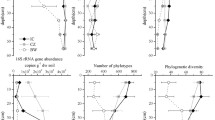Abstract
Overexploitation of rare earth mine has caused serious desertification and various environmental issues, and ecological restoration of a mining area is an important concern in China. In this study, experiments involving dry grass landfilling, chicken manure broadcasting, and plant cultivation were carried out to reclaim a rare earth mine area located in Heping County, Guangdong Province, China. The prime focus was to improve soil quality in terms of nutrients, microbial community, enzyme activity, and physicochemical properties so as to reclaim the land. After 2 years of restoration, an increase of organic matter (OM), available potassium (K), available phosphorus (P) levels, and acid phosphatase (ACP) activity and a reduction of the available nitrogen (N) level and urease (URE) activity in soil were achieved compared to the original mined land. The nutrients and enzyme activities in soil with 5 years of restoration were close to or surpass those in the unexploited land as control. The bulk density, total porosity, water holding capacity, pH, and electrical conductivity (EC) of soil were improved, and the number of cultivable microorganisms and the bacterial diversity in soil were greatly increased with time during ecological restoration, especially for surface soil. Furthermore, the artificial vegetation stably grew at the restored mining sites. The results indicated that organic amendments and phytoremediation could ecologically restore the rare earth mining sites and the mined land could finally be planted as farmland.




Similar content being viewed by others
References
Ali H, Khan E, Sajad MA (2013) Phytoremediation of heavy metals concepts and applications. Chemosphere 91:869–881
Amann RI, Ludwig W, Schleifer KH (1995) Phylogenetic identification and in situ detection of individual microbial cells without cultivation. Microbiol Rev 59:143–169
Audet P, Charest C (2007) Heavy metal phytoremediation from a meta-analytical perspective. Environ Pollut 147:231–237
Berti WWR, Cunningham SD (2000) Phytostabilization of metals. In: Raskin I, Ensley BD (eds) Phytoremediation of toxic metals—using plants to clean up the environment. Wiley, New York, pp 71–88
Botstein D, White RL, Skolnick M, Davis RW (1980) Construction of a genetic linkage map in man using restriction fragment length polymorphisms. Am J Hum Genet 32:314–331
Boukhris A, Laffont-Schwob I, Mezghani I, Kadri LE, Prudent P, Pricop A, Tatoni T, Chaieb M (2015) Screening biological traits and fluoride contents of native vegetations in arid environments to select efficiently fluoride-tolerant native plant species for in-situ phytoremediation. Chemosphere 119:217–223
Briuns MR, Kapil S, Oehme FW (2000) Microbial resistance to metals in the environment. Ecotoxicol Environ Saf 45:198–207
Canha N, Freitas MC, Anawar HM, Dionísio I, Dung HM, Pinto-Gomes C, Bettencourt A (2010) Characterization and phytoremediation of abandoned contaminated mining area in Portugal by INAA. J Radioanal Nucl Chem 286:577–582
Chang EH, Chiu CY (2015) Changes in soil microbial community structure and activity in a cedar plantation invaded by moso bamboo. App Soil Ecol 9:1–7
Chen CL, Liao M, Zen LS (2006) Determination method on structure diversity and function of micro flora in polluted soil. J Ecol 26:3404–3412
Compant S, van der Heijden MGA, Sessitsch A (2010) Climate change effects on beneficial plant-microorganism interactions. FEMS Microbiol Ecol 73:197–214
Conesa HM, Garcia G, Faz A, Arnaldos R (2007) Dynamics of metal tolerant plant communities development in mine tailings from the Cartagena-La Union Mining District (SE Spain) and their interest for further revegetation purposes. Chemosphere 68:1180–1185
Dick RP, Breakwell DP, Turco RF (1996) Soil enzyme activities and biodiversity measurements and integrative microbial indicators. In: Doran JW, Jones AJ (eds) Methods of assessing soil quality. Soil Science Society of America Inc., Madison, pp 247–271
Du S, Gao XZ (2006) Technological standard regulation for soil analysis. Chinese Agriculture Press, Beijing
Ernst WHO (2005) Phytoextraction of mine wastes—options and impossibilities. Chem Erde-Geochem 65:29–42
Itanna F, Coulman B (2003) Phyto-extraction of copper, iron, manganese, and zinc from environmentally contaminated sites in Ethiopia, with three grass species. Commun Soil Sci Plant Anal 34:111–124
Khan S, Hesham AEL, Qiao M, Rehman S, He JZ (2010) Effects of Cd and Pb on soil microbial community structure and activities. Environ Sci Pollut Res 17:288–296
Kızılkaya R, Bayraklı B (2005) Effects of N-enriched sewage sludge on soil enzyme activities. Appl Soil Ecol 30:192–202
Li MS (2006) Ecological restoration of mineland with particular reference to the metalliferous mine wasteland in China: a review of research and practice. Sci Total Environ 357:38–53
Li G, Quiros CR (2001) Sequence-related amplified polymorphism (SRAP), a neap marker system based on a simple PCR reaction: its application to mapping and gene tagging in Brassica. Theor Appl Genet 103:455–461
Li MS, Luo YP, Su ZY (2007) Heavy metal concentrations in soils and plant accumulation in a restored manganese mineland in Guangxi, South China. Environ Pollut 147:168–175
Liang H (2009) Research progress on phytoremediation in mining area. JZhongkai Agric Eng Univ 22:56–60
Liu W, Ke HP, Liang H (2008) A broad-suitable method for total nucleic acid extraction of plants and animals. J Zhongkai Agric & Eng Univ 21(3):17–21
Liu J, Zhang XH, Li TY, Wu QX, Jin ZJ (2014) Soil characteristics and heavy metal accumulation by native plants in a Mn mining area of Guangxi, South China. Environ Monit Assess 186:2269–2279
Liu SH, Wang GY, Yan YR, Liang H, Zhou LY (2015) Research on drought resistance and uptake capacity of heavy metal of three kinds of herbaceous plants. Res Soil Water Conserv 22:1–6
Lu RK (2000) Analysis method of soil agricultural chemistry. Chinese Agriculture Press, Beijing
Madejón P, Murillo JM, Maraňón T, Cabrera F, Soriano MA (2003) Trace element and nutrient accumulation in sunflower plants two years after the Aznalcóllar mine spill. Sci Total Environ 307:239–257
Malcolm GM, López-Gutiérrez JC, Koide RT (2009) Little evidence for respiratory acclimation by microbial communities to short-term shifts in temperature in red pine (Pinus resinosa) litter. Glob Chang Biol 15:2485–2492
Mani D, Kumar C (2014) Biotechnological advances in bioremediation of heavy metals contaminated ecosystems: an overview with special reference to phytoremediation. Int J Environ Sci Technol 11:843–872
Marrugo-Negrete J, Durango-Hernández J, Pinedo-Hernández J, Olivero-Verbel J, Díez S (2015) Phytoremediation of mercury-contaminated soils by Jatropha curcas. Chemosphere 127:58–63
Martínez-Ruiz C, Fernández-Santos B, Putwain PD, Fernández-Gómez MJ (2007) Natural and man-induced revegetation on mining wastes: changes in the floristic composition during early succession. Ecol Eng 30:286–294
Massenssini AM, Bonduki VHA, Melo CAD, Tótola MR, Ferreira FA, Costa MD (2015) Relative importance of soil physico-chemical characteristics and plant species identity to the determination of soil microbial community structure. Appl Soil Ecol 91:8–15
Melillo JM, Steudler PA, Aber JD, Newkirk K, Lux H, Bowels FP, Catricala C, Magill A, Ahrens T, Morrisseau S (2002) Soil warming and carbon-cycle feedbacks to the climate system. Science 298:2173–2176
Mendez MO, Maier RM (2008) Phytoremediation of mine tailings in temperate and arid environments. Rev Environ Sci Biotechnol 7:47–59
Mendez MO, Glenn EP, Maier RM (2007) Phytostabilization potential of quailbush for mine tailings: growth, metal accumulation, and microbial community changes. J Environ Qual 36:245–253
Moynahan OS, Zabinski CA, Gannon JE (2002) Microbial community structure and carbon-utilization diversity in a mine tailings revegetation study. Restor Ecol 10:77–87
Munshower FF (1994) Practical handbook of disturbed land revegetation. CRC, Boca Raton
Olsen GJ, Lane DJ, Giovannoni SJ, Pace NR, Stahl DA (1986) Microbial ecology and evolution: a ribosomal RNA approach. Annu Rev Microbiol 40:337–365
Pérez-de-Mora A, Madrid F, Cabrera F, Madejón E (2007) Amendments and plant cover influence on trace element pools in a contaminated soil. Geoderma 139:1–10
Piha MI, Vallack HW, Michael N, Reeler BM (1995) A low input approach to vegetation establishment on mine and coal ash wastes in semiarid regions II. Lagooned pulverized fuel ash in Zimbabwe. J Appl Ecol 32:382–390
Raskin I, Smith RD, Salt DE (1997) Phytoremediation of metals: using plants to remove pollutants from the environment. Curr Opin Biotechnol 8:21–226
Renella G, Landi L, Ascher J, Ceccherini MT, Pietramellara G, Mench M, Nannipieri P (2008) Long-term effects of aided phytostabilisation of trace elements on microbial biomass and activity, enzyme activities, and composition of microbial community in the Jales contaminated mine spoils. Environ Pollut 152:702–712
Rosario K, Iverson SL, Henderson DA, Chartrand S, McKeon C, Glenn EP, Maier RM (2007) Bacterial community changes during plant establishment at the San Pedro River mine tailings site. J Environ Qual 36:1249–1259
Rotkittikhun P, Kruatrachue M, Chaiyarat R, Ngernsansaruay C, Pokethitiyook P, Paijitprapaporn A, Baker AJM (2006) Uptake and accumulation of lead by plants from the Bo Ngam lead mine area in Thailand. Environ Pollut 144:681–688
Schimel J, Balser TC, Wallenstein M (2007) Microbial stress-response physiology and its implications for ecosystem function. Ecology 88:1386–1394
Seenivasan R, Prasath V, Mohanraj R (2014) Restoration of sodic soils involving chemical and biological amendment and phytoremediation by Eucalyptus camalulensis in a semiarid region. Environ Geochem Health. doi:10.1007/s10653-014-9674-8
Stiles AR, Liu C, Kayama Y, Wong J, Doner H, Funston R, Terry N (2011) Evaluation of the boron tolerant grass, Puccinellia distans, as an initial vegetative cover for the phytorestoration of a boron-contaminated mining site in southern California. Environ Sci Technol 45:8922–8927
Stojanović MD, Mihajlović ML, Milojković JV, Lopićić ZR, Adamović M, Stanković S (2012) Efficient phytoremediation of uranium mine tailings by tobacco. Environ Chem Lett 10:377–381
Tordoff GM, Baker AJM, Willis AJ (2000) Current approaches to the revegetation and reclamation of metalliferous mine wastes. Chemosphere 41:219–228
Ushio M, Kitayama K, Balser TC (2010) Tree species-mediated spatial patchiness of the composition of microbial community and physicochemical properties in the topsoils of a tropical montane forest. Soil Biol Biochem 42:1588–1595
Wang P, Liu SF (2008) Soil erosion in South China rare earth mine. J Chin Soil Water Conserv 310:48–50
Wang X, Liu YG, Zeng GM, Chai LY, Xiao X, Song XC, Min ZY (2008) Pedological characteristics of Mn mine tailings and metal accumulation by native plants. Chemosphere 72:1260–1266
Yang WQ, Wang KY (2004) Advances in forest soil enzymology. Sci Silvae Sin 40:152–159
Yang SX, Liao B, Li JT, Guo T, Shu WS (2010) Acidification, heavy metal mobility and nutrient accumulation in the soil-plant system of a revegetated acid mine wasteland. Chemosphere 80:85–859
Ye ZH, Wong JWC, Wong MH, Lan CY, Baker AJM (1999) Lime and pig manure as ameliorants for revegetation lead/zinc mine tailings: a greenhouse study. Bioresour Technol 69:35–43
Ye ZH, Shu WS, Zhang ZQ, Lan CY, Wong MH (2002) Evaluation of major constraints to revegetation of lead/zinc mine tailings using bioassay techniques. Chemosphere 47:1103–1111
Yoon J, Cao X, Zhou Q, Ma LQ (2006) Accumulation of Pb, Cu, and Zn in native plants growing on a contaminated Florida site. Sci Total Environ 368:456–464
Yu XB, Mo XY, Long T, Yang WD (1996) Study on litter fall and nutrient composition of eucalypt plantation with different continuous plant rotations. J Hainan Univ (Nat Sci) 6:140–144
Zhang NL, Guo JX (2007) Soil microbial feedbacks to climate warming and atmospheric N deposition. J Plant Ecol 31:252–261
Zhang PJ, Pan GX (2010) Changes of soil microbial communities and activities along a vegetation succession in karst soil: a case study of Stone Forest, Yunnan, China. Geogr Res 29:223–234
Zou TJ, Li TX, Zhang XZ, Yu HY, Huang HG (2012) Lead accumulation and phytostabilization potential of dominant plant species growing in a lead-zinc mine tailing. Environ Earth Sci 65:621–630
Zuberer DA (1994) Recovery and enumeration of viable bacteria. In: Bigham JM (ed) Methods of soil analysis. Part 2, microbiological and biochemical properties. Soil Science of America Inc, Madison, pp 119–144
Acknowledgments
We thank Dr. Qing X. Li from the University of Hawaii at Manoa, USA, for his comments on this manuscript. This work was supported by Guangdong Provincial S & T Department under the Production-Education-Research Cooperation Project between Guangdong Province and the National Education Ministry of China (Nos. 2010B090400465 and 2012B090900010).
Author information
Authors and Affiliations
Corresponding author
Additional information
Responsible editor: Zhihong Xu
Appendix
Appendix
Rights and permissions
About this article
Cite this article
Zhou, L., Li, Z., Liu, W. et al. Restoration of rare earth mine areas: organic amendments and phytoremediation. Environ Sci Pollut Res 22, 17151–17160 (2015). https://doi.org/10.1007/s11356-015-4875-y
Received:
Accepted:
Published:
Issue Date:
DOI: https://doi.org/10.1007/s11356-015-4875-y




